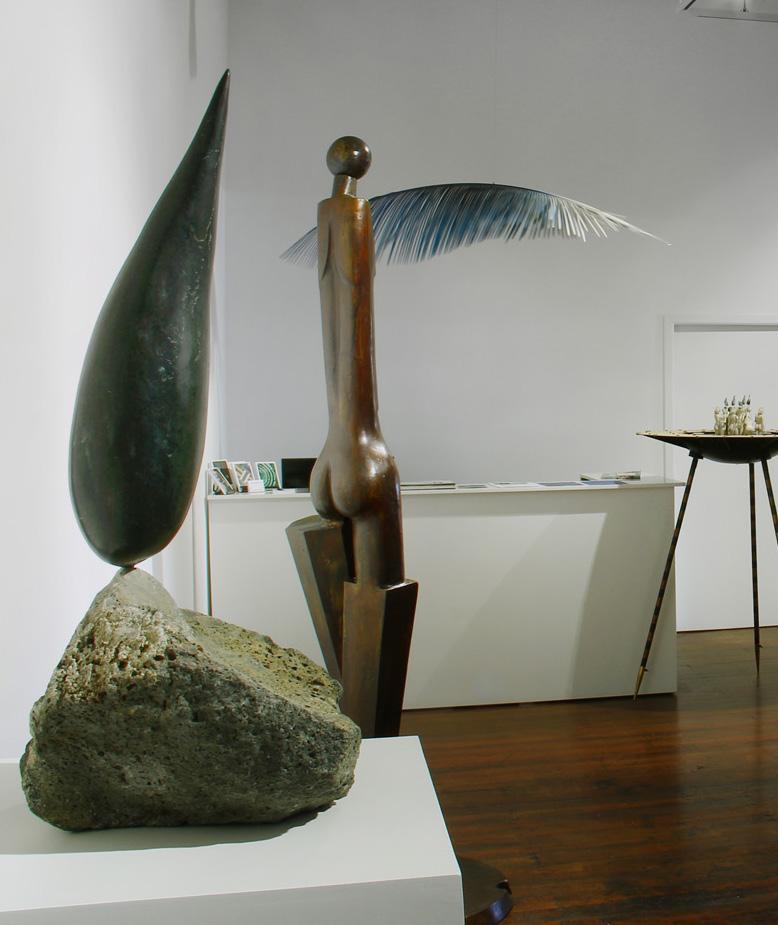TŪHURA SCULPTURE INVITATIONAL
17 February- 15 April 2023



Tūhura (meaning to discover, disclose, bring to light, unearth, open up, explore, investigate) is a significant exhibition of contemporary New Zealand sculpture, featuring career-defining works by fifteen sculptors.
Tūhura is the largest exhibition ever presented by a gallery or institution devoted entirely to New Zealand sculpture.
Uniting these fifteen sculptors are numerous dialogues: about identity, location, reverence for the landscape, the numerous man-induced threats facing all of us, the role and reality of history in our emergent values, time-passed time-present timefuture, the role(s) of spirituality in our existence, what is seen and what is not, Pacific navigation, pattern-making, light and darkness, and, of course, the very presence and celebration of the human body itself.
Tūhura reveals sculpture practise in New Zealand to be not simply engaged with significant issues and debates about who we are and where we are going but also to be at the forefront of philosophical and narrative discourse that could only be from here.
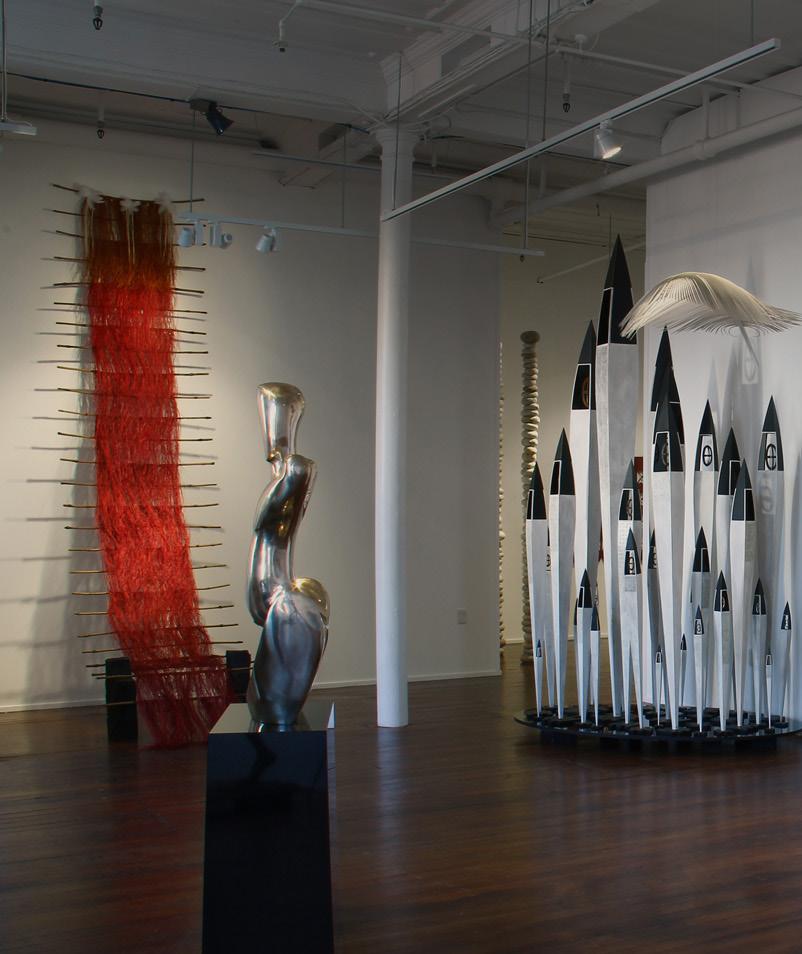

Te Ngau o te Rangi (2021)
cast bronze, patina, wax
edition of 5 + 2 AP
size: 1180 x 630 x 280 mm
By day this deeply relief-sculpted work represents Tāwhirimātea, the Māori male god of weather and the personification of the weather in traditional Māori narratives, and by night the female god of weather, and Tawhiri’s wife, Hine-mai-oho-rangi.
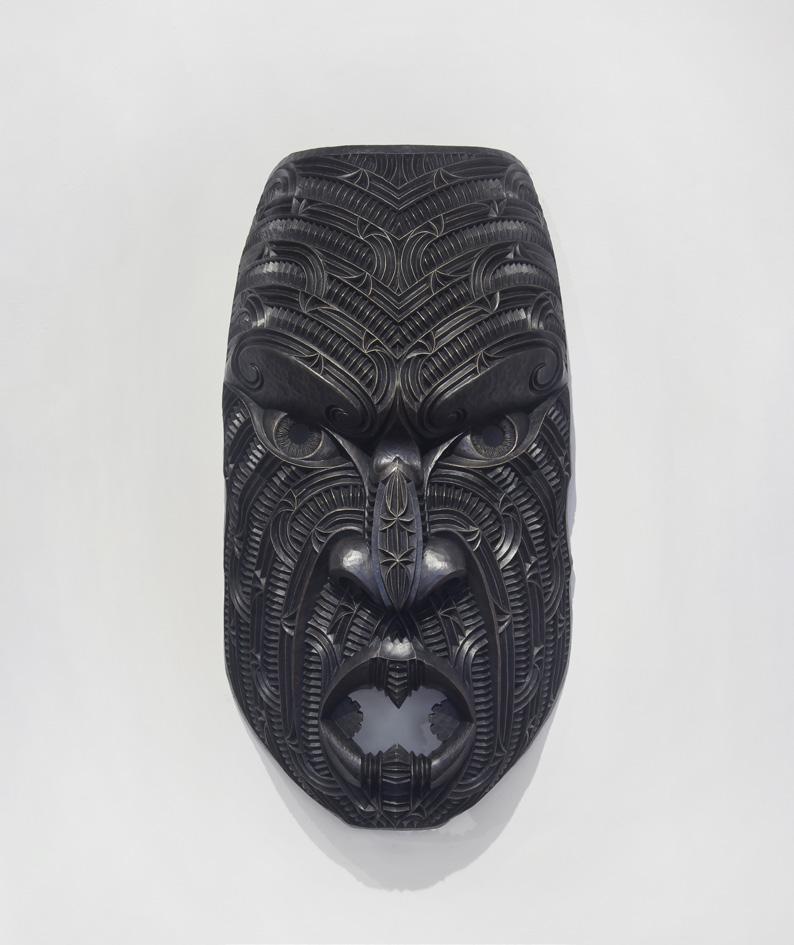
5 pieces, tōtara, shou sugi ban finish installation size on wall: 1545 x 1940 x 200 mm individual pieces signed, dated, titled “Ruawehea” verso
Chris Bailey’s sculptures are physical and symbolic markers of place, identity and history. They describe the artist’s relationship to his whenua and tīpuna. In Te Iti ō Hauraki Bailey depicts the artist’s female ancestor Ruawhea whose ancestral claim to Hauraki allowed the descendants of Marutūāhu to enter the area once she married Tamaterā. The work depicts Ruawhea flanked by her offspring, who feature in the whakapapa of many Hauraki iwi.
Bailey has used a burning process of hand-polished, flame-charred tōtara to add a rich lustre. This enhances the feeling that the soft indentations or scoops covering the surfaces could have been pressed into the wood by their maker’s hand. The carvings have a sensuous fleshiness, a soft skin that resonates with the saying they reference:
Haere mai, nau mai
Haere mai, kuhu noa mai ki ngā hūhā o Ruawehea
Come forth, welcome
Come forth and enter the thighs of Ruawhea

Be It On Our Heads (2017) photogrammetry, printed stone composite figures, steel, acrylic sheet, bamboo, copper brass size: 1530 x 1000 x 1000 mm
The importance of recognising that we are wholly complicit in our ecological future is clear in Be It On Our Heads. Bennett draws the central motif in this work from Hieronymus Bosch’s triptych Garden of Earthly Delights. The fourteenth century work is a revelatory vision of a world fashioned by humankind to suit its own purposes. While the beasts and birds of Bosch’s panels appear to exist in concert with the human inhabitants of the garden, Bennett uses images of Aotearoa’s endangered matuku, bittern, whose wetlands are increasingly polluted or have disappeared entirely.
Bosch’s pond is reimagined in steel, bamboo, copper, and brass. The human (and matuku) figures are tightly bound by the pond’s circumference but there is a sense of collective stasis in the vague, desultory gestures. Perched on high, the figures occupy the centre of the work but are dwarfed in scale by the structure of the sculpture itself. We need to ask if Bennett wants us to consider the outsize impact of anthropogenic decisions on a world in which we are but one element.
Graham Bennett’s conceptual rigour is embedded in all aspects of his sculptural practice. Bennett combines theories of form, space, and materiality with intellectual investigations into ecological and social concerns.
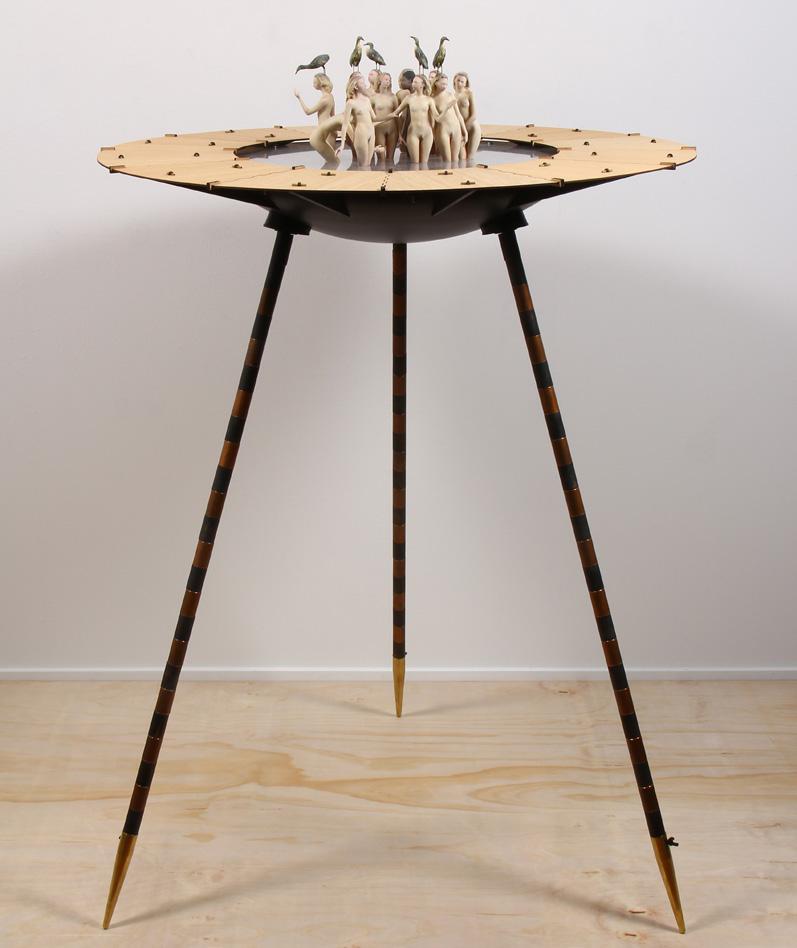
acrylic sheet, MDF, painted wood, steel size: 2620 x 1805 x 1180 mm
‘Converse is an evolution of ideas, originally comprising 60 pod forms made from painted composition board and ranging in scale up to four metres high. The pod-like form evolved over time from an abstraction of segments of the globe as described by lines of longitude and latitude. Segments are an antipodean world view – with the aperture at the location of Aotearoa New Zealand inverted.’
‘Each pod speaks of intervention. The central eye or core… formed the nucleus of a series of earlier collaborative works, Karihi. Formed in mild steel, they are rusted in the Pacific Ocean, and then lacquered.’
‘The external pattern (a Bennett graphic) is a symbol begun as part of the Sea/Sky/Stone installation at the geographic centre of New Zealand in 1991. The pattern incorporates notions of architectural forms overlaying a circle (stone/globe forms), navigational and geographic trajectories. Seeming grounded in the Pacific, this is a personal description using universal symbols.’
‘The steel base plates, once interlocking, have drifted apart. Scale and placement force a dialogue between components. The eerie sense of remoteness in this work conjures up a sense of searching which extends beyond the physical references to social and cultural connections. Individuality confronts a sea of humanity evoking conversations around independence and collectiveness and the sense of self that is defined by place, group, brand. As usual for Bennett this work poses more questions than answers – key notions being the power of the group - What isolates? What unites? What uncertain future are these markers facing? Could these be markers of the Anthropocene?’1
1 Graham Bennett, artist notes, retrieved 15/3/2023
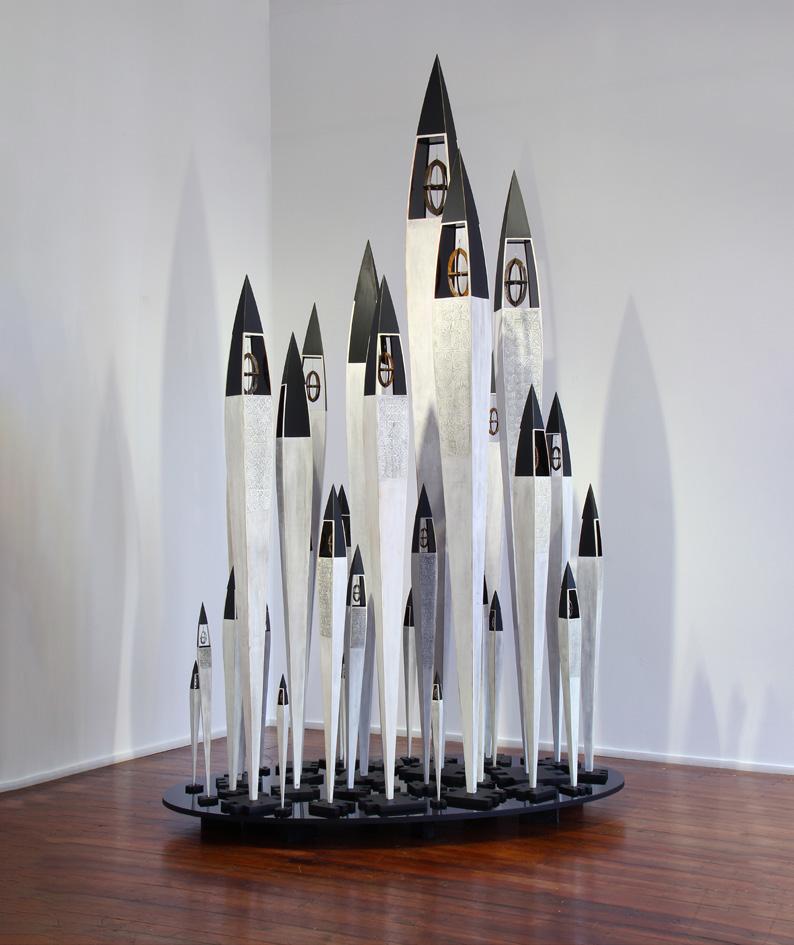
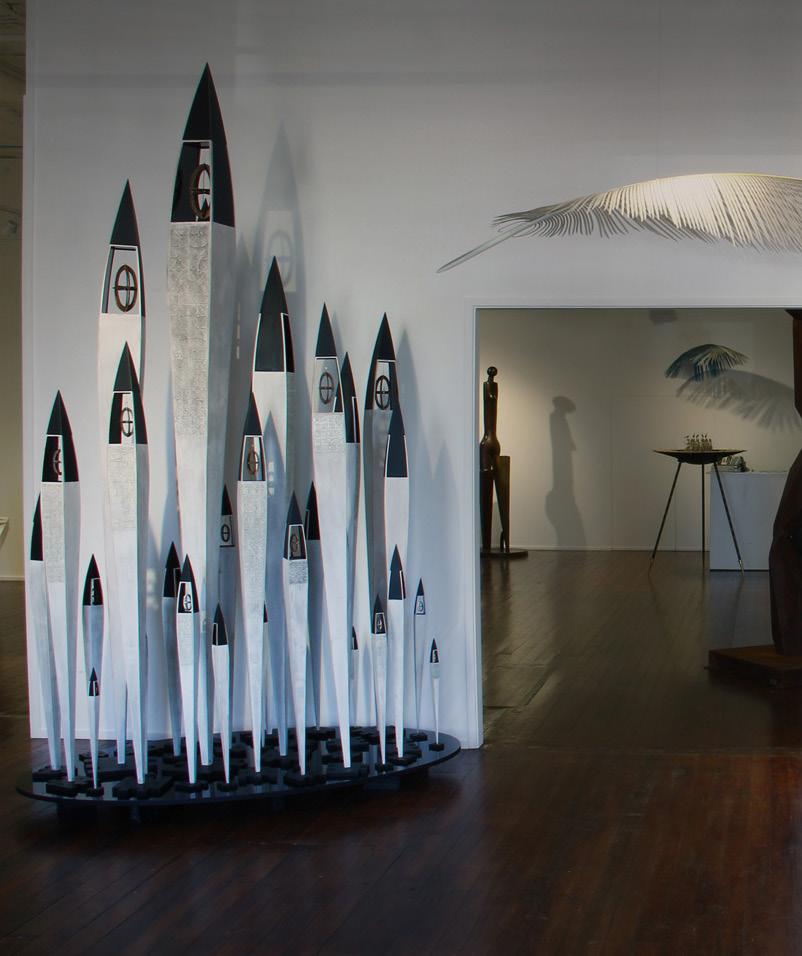
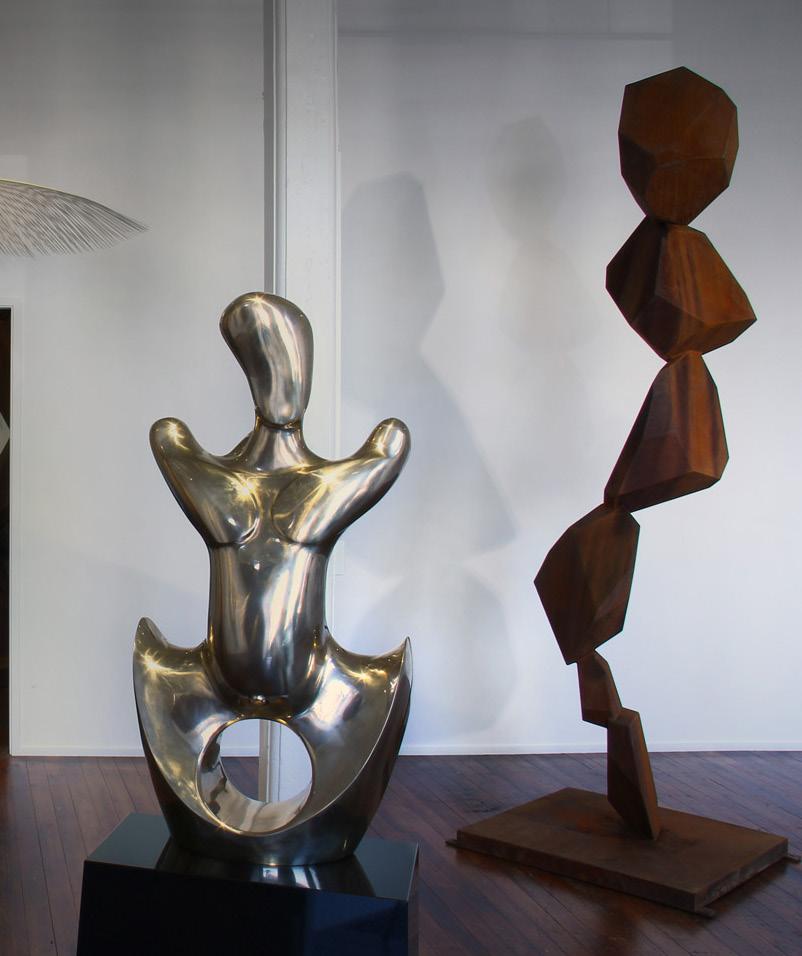
Hawks Crag (2015)
South Island granite, stainless steel installation: 3070 x 1000 x 200 mm (variable)
Chris Booth is a major figure in New Zealand sculpture with ‘his own, highly recognisable sculptural language.’1
Employing a ‘Japanese reverence for nature… the result looks effortless and perfectly authentic’.2
Booth’s works are ‘responses to specific geographical location’ and demonstrate acute understandings of geological history, close observation of nature and represent ‘the idea of making landscape into sculpture.’3
1 Edward Lucie-Smith, ‘Foreword,’ Woven Stone: The Sculpture of Chris Booth, Godwit 2007, p.8
2 Ken Scarlett, ibid p.289
3 Edward Lucie-Smith, ibid p.8-9

Te Waimate (2023)
basalt, steel
two columns, 6000 mm and 4000 mm high
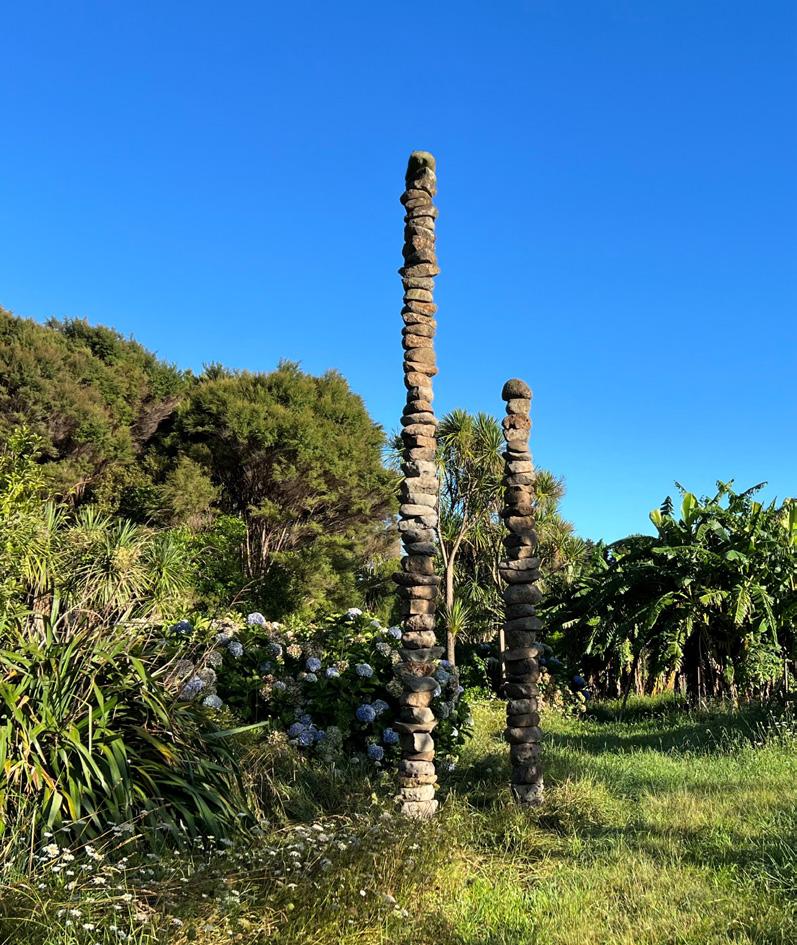
Southland golden quartz, handplaited Fijian coconut fibre, stainless steel cable size on wall: 2310 x 1010 x 100 mm (variable)
The necklace form in sculptural scale with its subliminal messages of love, spirituality and place, and South Pacific symbolism is now firmly linked to Chris Charteris. In Wasekaseka Charteris builds a broad cultural metaphor: the title explicitly references the Fijian necklace made from split whale teeth and bound with coconut fibre which is worn by chiefs and represents high honour. In this iconic work with the stones of Southland golden quartz stacked like serrated teeth, Charteris celebrates nature’s hand in the materials while celebrating and uniting South Pacific cultures.

triptych; Coromandel basalt
stone 1: 393 x 580 x 265 mm
stone 2: 347 x 625 x 245 mm
stone 3: 427 x 555 x 285 mm
signed, dated “CC 2022” verso each stone
Each part of the monumental work Trinity (2022) speaks to the other. The polished lines that cut across the irregular shapes are like letter-forms from the same script, each slightly different but clearly of the same language. The lines undulate over the surface of each stone, tracing its internal shape. The weathered yellow-orange surfaces seem to have been peeled back in strips; a deceptively simple finish that belies Charteris’ exceptional skill. The igneous origins revealed in the fine-grained, grey interior contrasts with the stones’ exterior oxidisation - geologically speaking, a more recent development.
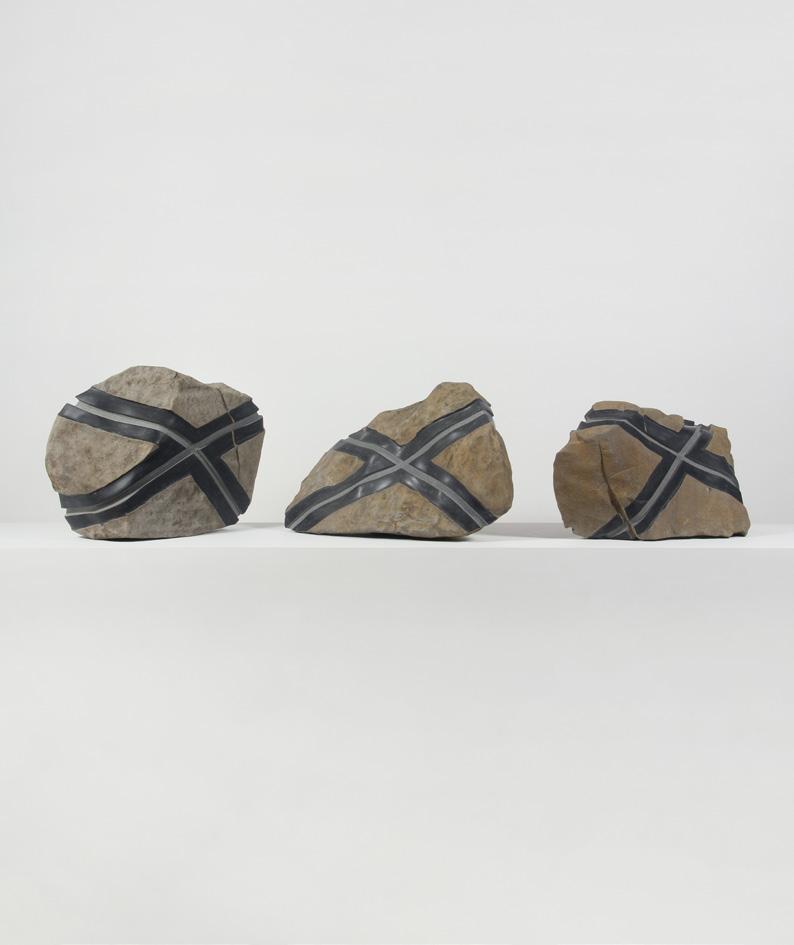

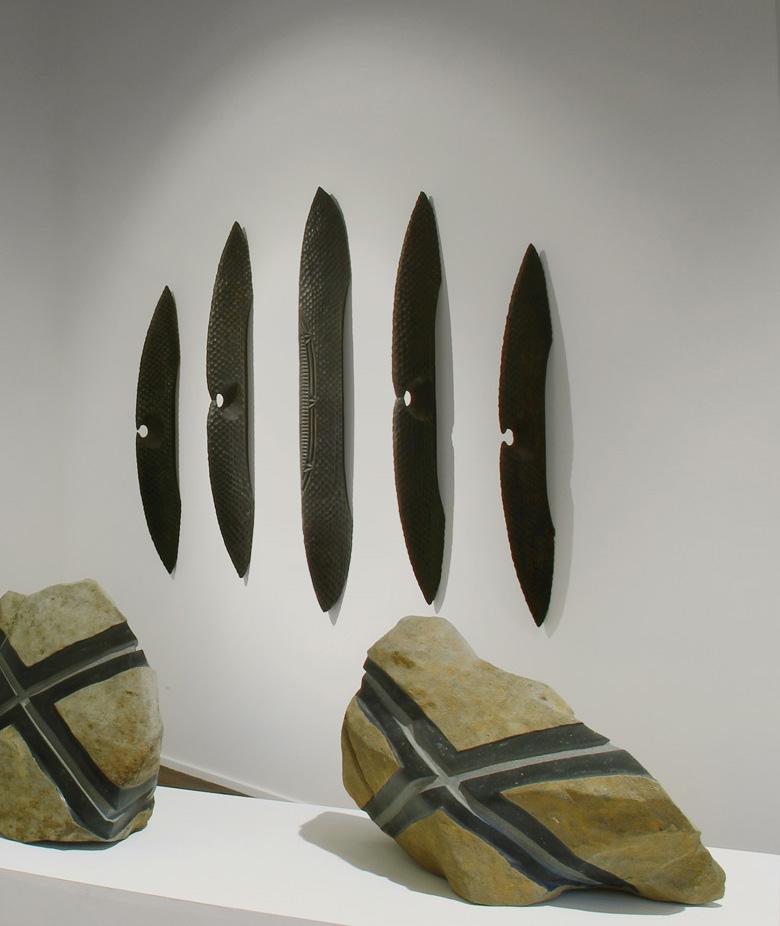
Great Southern Ocean (Triple Strand) (2022) triptych; Southland granite and hardstone, stainless steel cable size on wall: 2320 x 1056 x 150 mm (variable)
Chis Charteris’ iconic necklace works combine the specifics of place with harmonic metaphors of love and the sensations of journeying. Plural as well as disarmingly beautiful, Charteris builds monumentally simple, poignant emblems of the Pacific while celebrating the cultures it contains.
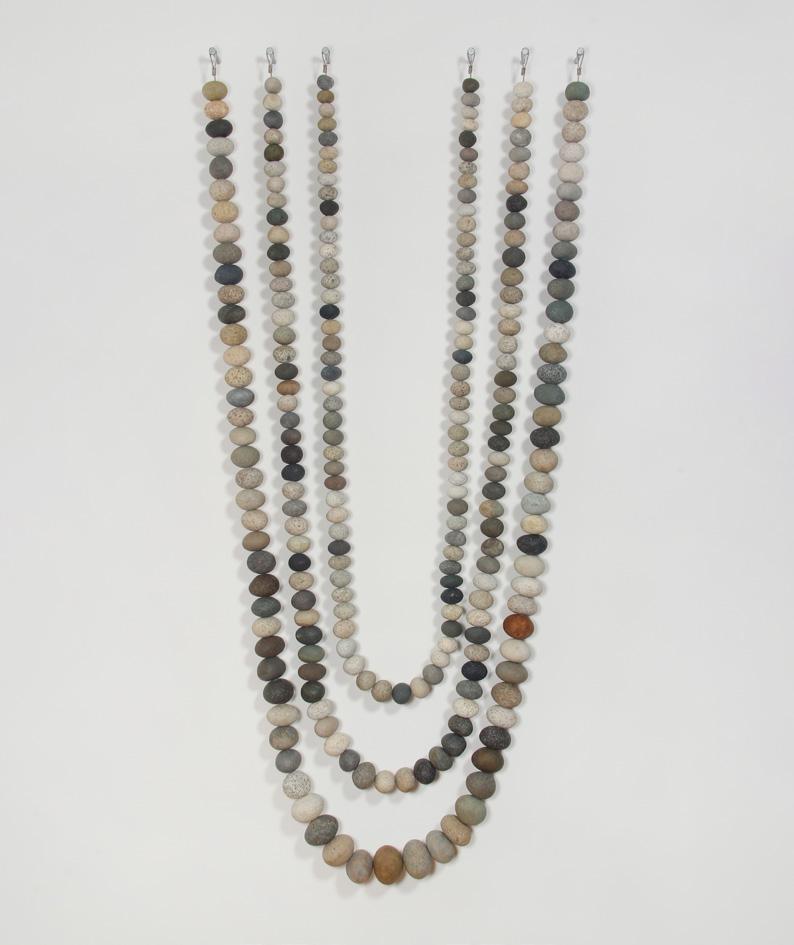
acrylic, aluminium, polycarbonate, automotive paint
size: 270 x 1970 x 880 mm
Playful and masterful, defying gravity yet as light as a feather, Neil Dawson’s spectacular use of colour, light, shade and shadow is quite simply unparalleled. Using parallax, the articulations of shadow and the lightest, deftest touch, Dawson has us see anew. He elevates the wall-mounted feather into a sculpted poem about the natural world. In the suspended feathers, quite different enveloping, protective sensations and patterns emerge. Light shimmers and most remarkably, as each slowly rotates in the shadows, down-beat wings emerge as the bird flies again.
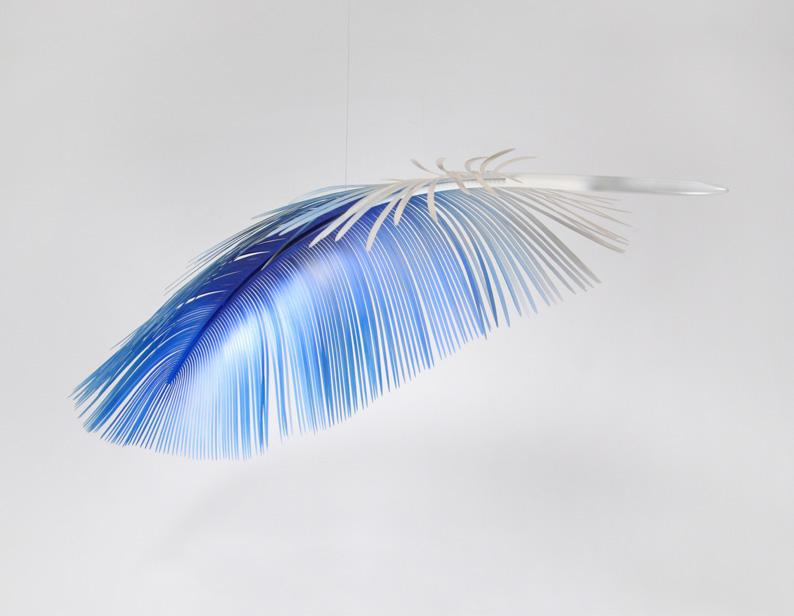


11
Yellow Down (2023)
acrylic, aluminium, polycarbonate, automotive paint
size: 280 x 2000 x 870 mm
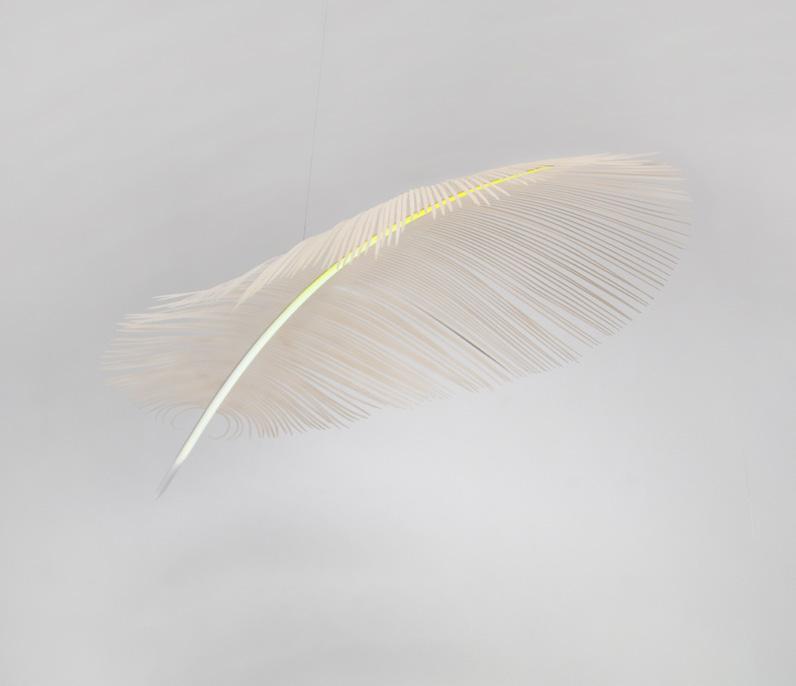


12
Kaka Down Feather (2022)
acrylic, aluminium, polycarbonate, automotive paint
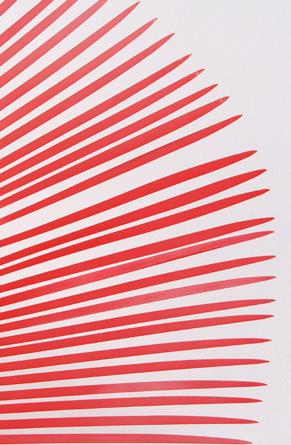
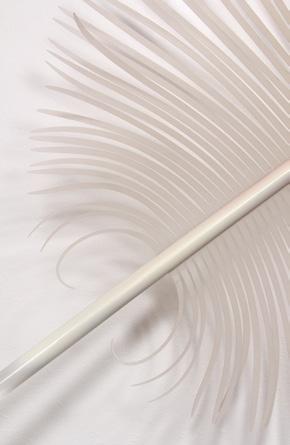
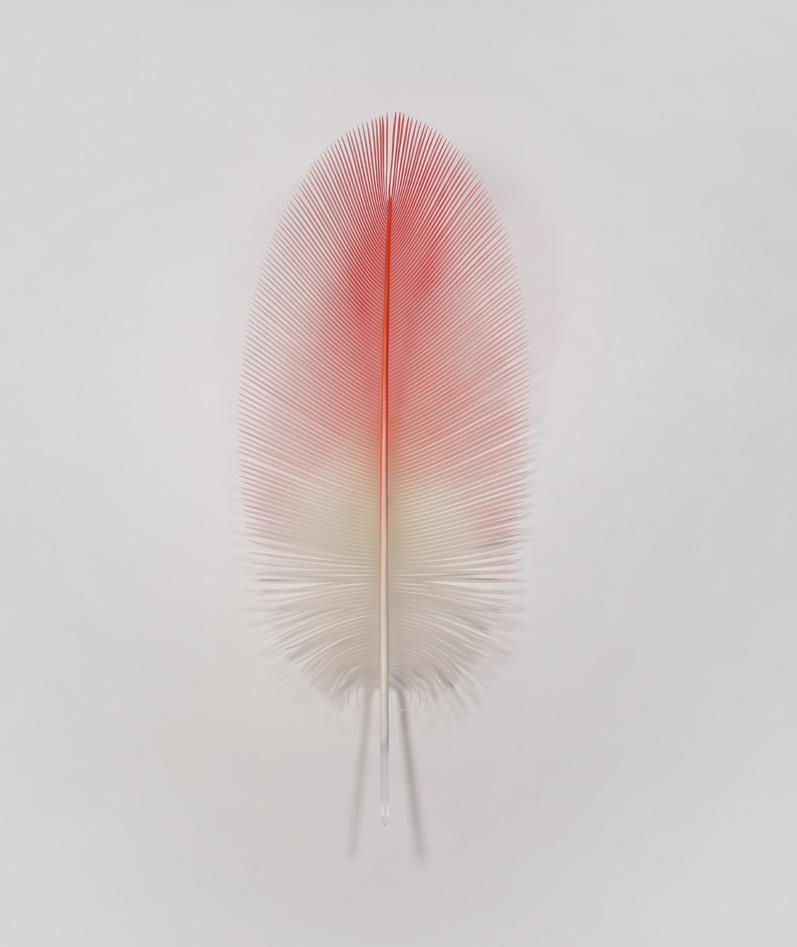
Parallel Worlds (2013)
cast bronze, corten steel
edition 1/1 + 1 AP
size: 3430 x 2116 x 807 mm
Parallel Worlds is one of Paul Dibble’s most important works. It features the huia which became for the artist ‘his adopted personal icon. The huia is intended to represent the Tararua mountain range, under which Dibble’s studio in Palmerston North shelters, for it was in the Tararuas that the last living huia was supposedly sighted. They were beautiful birds, their extinction a sad morality tale… The birds had evolved into the ultimate co-dependent couple… The loss of one bird resulted in the death of that complete family unit.’1
Prized by Māori ‘for their tail feathers, recognised as a symbol of privilege… worn in the hair of chiefs and kept safe in waka huia (treasure boxes)’ with the arrival of ornithologists like ‘well-known Buller… The Birds didn’t stand a chance.’2
Using the metaphors of an abstracted tree upon which the huia perches with the circle of life underneath, Dibble delivers the symbolism and ultimate paradox of the tall, striding figure heading in a different direction.
2 Ibid
1 Paul and Fran Dibble, Paul Dibble: X - A Decade of Sculpture 2010-2020, Bateman, 2020, p. 109.

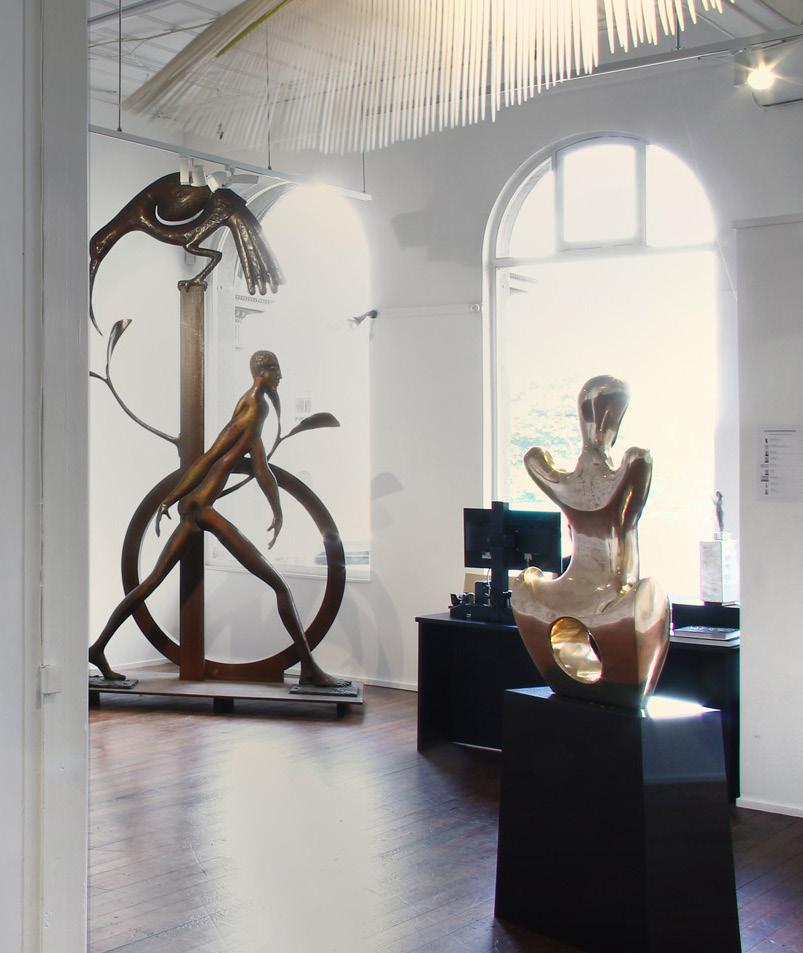
cast bronze
AP 1/1 + edition of 2
size: 2340 x 690 x 690 mm
signed, dated on base
Central to Paul Dibble’s oeuvre is a formalist, reductive aesthetic where the naked, exposed body is presented in an expressive and sensual manner in a visual language of geometric symbols. Playing with gesture and cubist sculpture itself, Dibble imbues his work with character and a powerful ‘sense of outgoing humanity.’1
Pricelist

9 pieces; Taranaki tōtara, linseed oil
installation size on wall: 1840 x 1980 x 100 mm
Nine wall-mounted figures arching like the sky and a wharenui roofline acknowledge and celebrate the advent of Matariki as the first indigenous holiday. It collectively personifies the whetū, stars, the work of kaiwhatu, weavers, and tohunga whakairo, carvers connecting elements of kaitiakitanga, guardianship with that of taiao, nature.
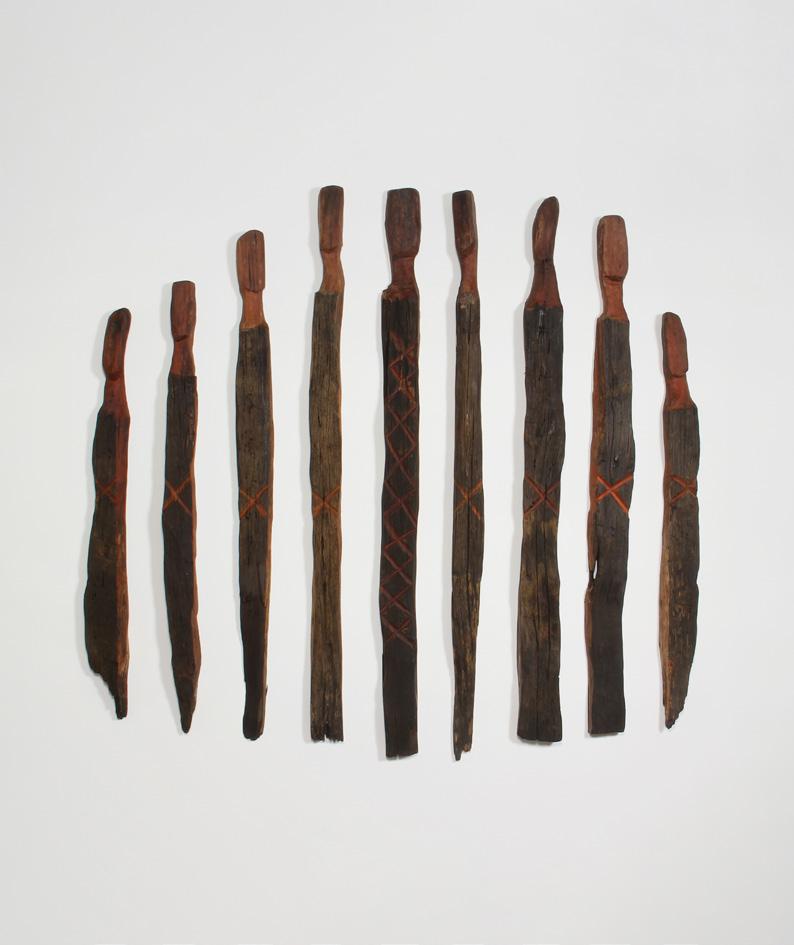

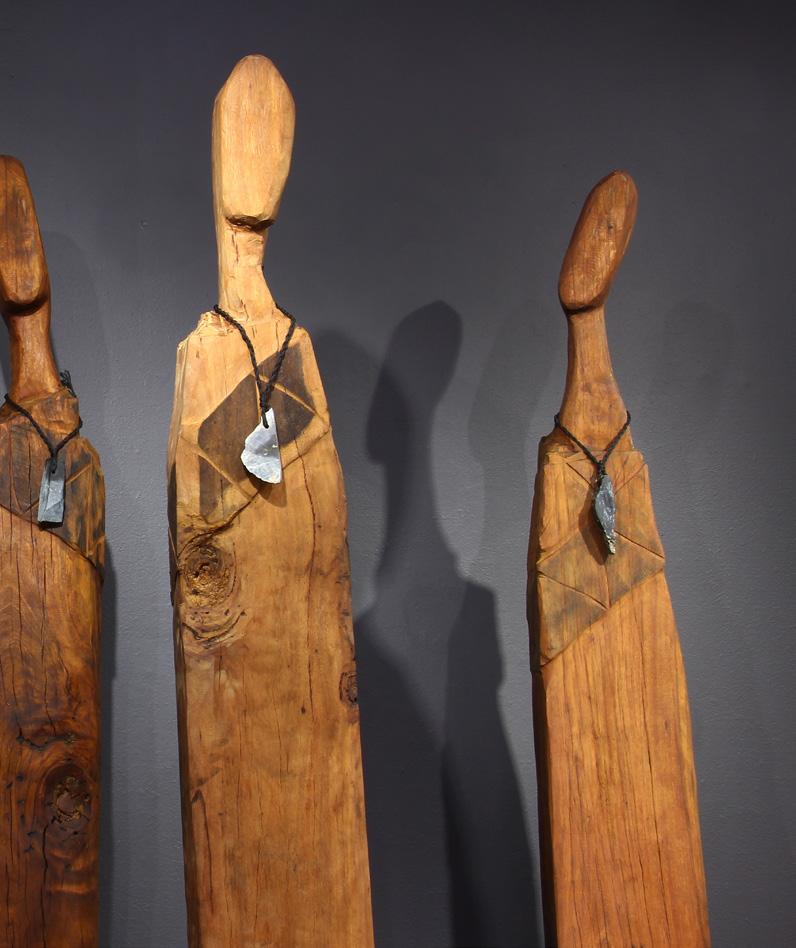 Anton Forde, Whakaruru / Protectors (2022)
Anton Forde, Whakaruru / Protectors (2022)
Whakaruru / Protector 6 (2022)
Australian hardwood, pounamu taonga, linseed oil
pou: 2670 x 250 x 120 mm
taonga: 130 x 30 x 35 mm
Whakaruru / Protector 13 (2022)
Australian hardwood, pounamu taonga, linseed oil
pou: 2750 x 260 x 125 mm
taonga: 110 x 45 x 35 mm
Whakaruru / Protector 15 (2022)
Australian hardwood, pounamu taonga, linseed oil
pou: 2770 x 250 x 130 mm
taonga: 95 x 80 x 35 mm
Whakaruru / Protector 16 (2022)
Australian hardwood, pounamu taonga, linseed oil
pou: 2745 x 258 x 127 mm
taonga: 113 x 56 x 20 mm
Whakaruru / Protector 17 (2022)
Australian hardwood, pounamu taonga, linseed oil
pou: 2732 x 260 x 125 mm
taonga: 115 x 57 x 22 mm
Anton Forde’s pou are time-travelling sentinels. All seeing, all knowing, individually and collectively they stand as guardians and protectors. Each pou is also as obviously listening. They are replete with individual characteristics and inclined heads, carved patterns and adornments. The accretive resonance and power of these exists in their silence, for ‘it is impossible not to imagine expressions,’1 or thought, and to talk back to the wisdom and warning they so clearly contain.
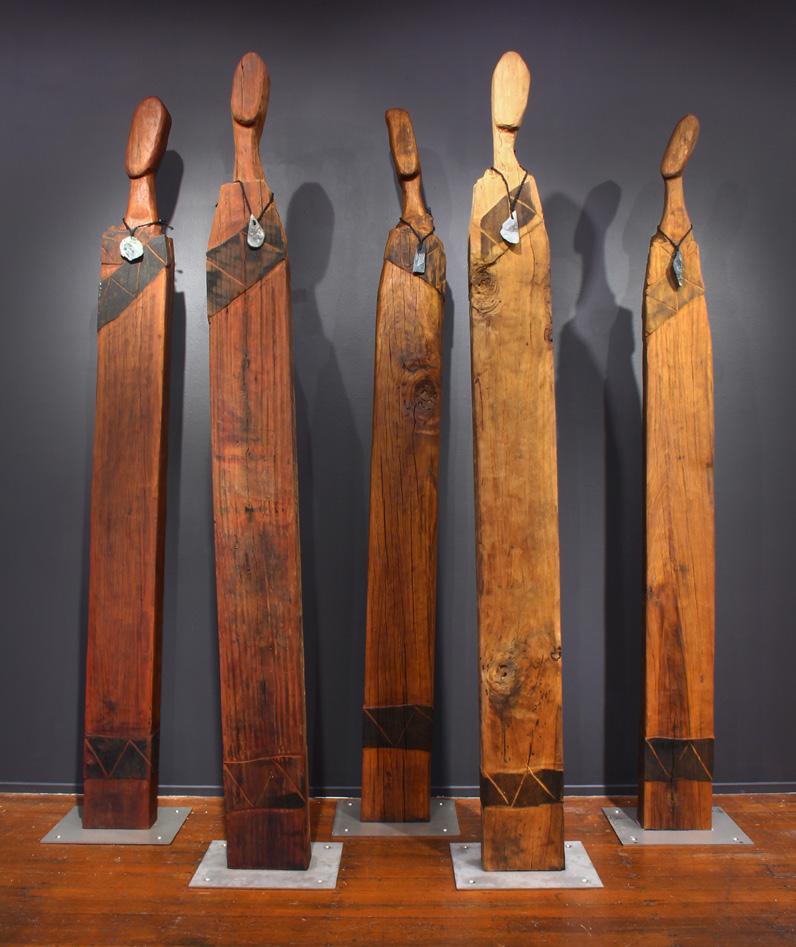
Māhutonga Roimata Uriuri - The Southern Cross Dark Teardrop (2021) pounamu (uriuri, tangiwai), basalt (Albert Barracks wall, Auckland)
overall size: 870 x 450 x 390 mm
pounamu sculpture: 580 x 160 x 160 mm
Also a very accomplished stone sculptor, Anton Forde’s acute sympathy for that material is amply represented in his very particular use of rare black pounamu. Delivered with remarkable restraint and tenderness, Forde builds an engaging visual metaphor of a teardrop form while into the surface of pounamu he has carved the Southern Cross. A roimata is a teardrop often linked with rain. The black of the stone reminds us at night the Southern Cross formation is seen. It was of pivotal importance for navigation and where the anchor for the celestial canoe was located.
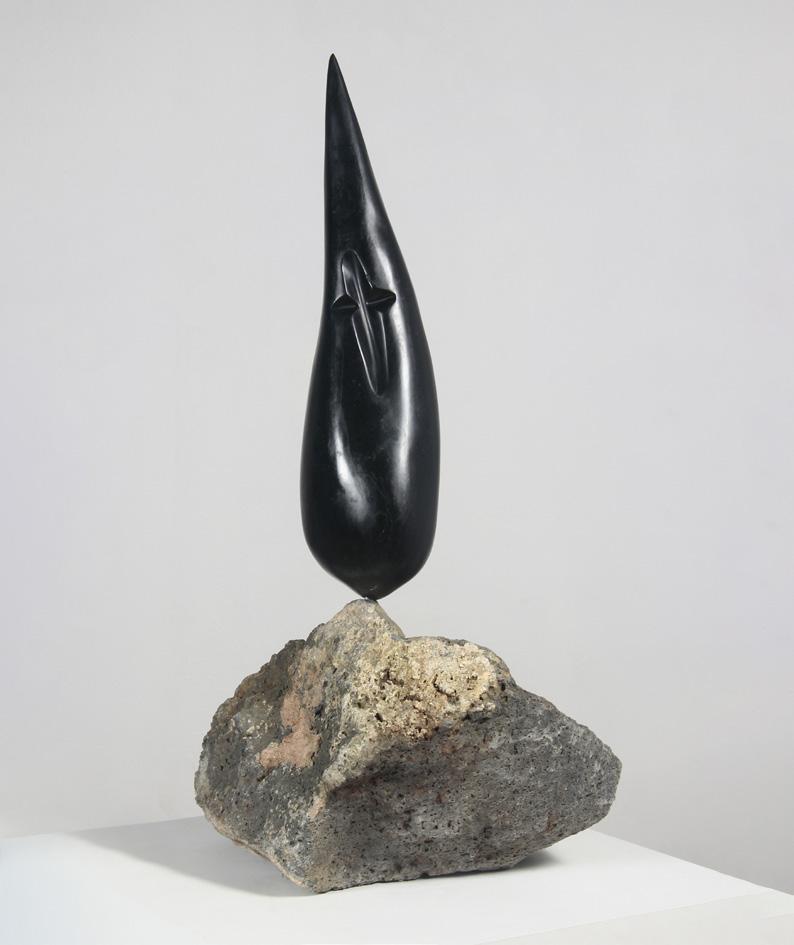
Our Lady (2003)
cast bronze, granite plinth
edition 1/3 + 1 AP
sculpture: 1070 x 540 x 245 mm
plinth: 798 x 682 x 400 mm
Lyonel Grant acknowledged as a master carver and sculptor has undertaken numerous major marae projects. Our Lady had its genesis back in the 1990’s where a small miscast work kept drawing Lyonel Grant to it, insisting it needed to be scaled up. The result is a reinterpreted figurative work directly informed by the symbolism and traditions of Māori iconography but one taken to a more formal internationalist language where it might be read in a more plural cultural context. Sensual. noticeably fluid and organic, Our Lady traverses time and place while honouring ‘the ihi, wehi and mauri – the power, awe and life force – of customary taonga.’1
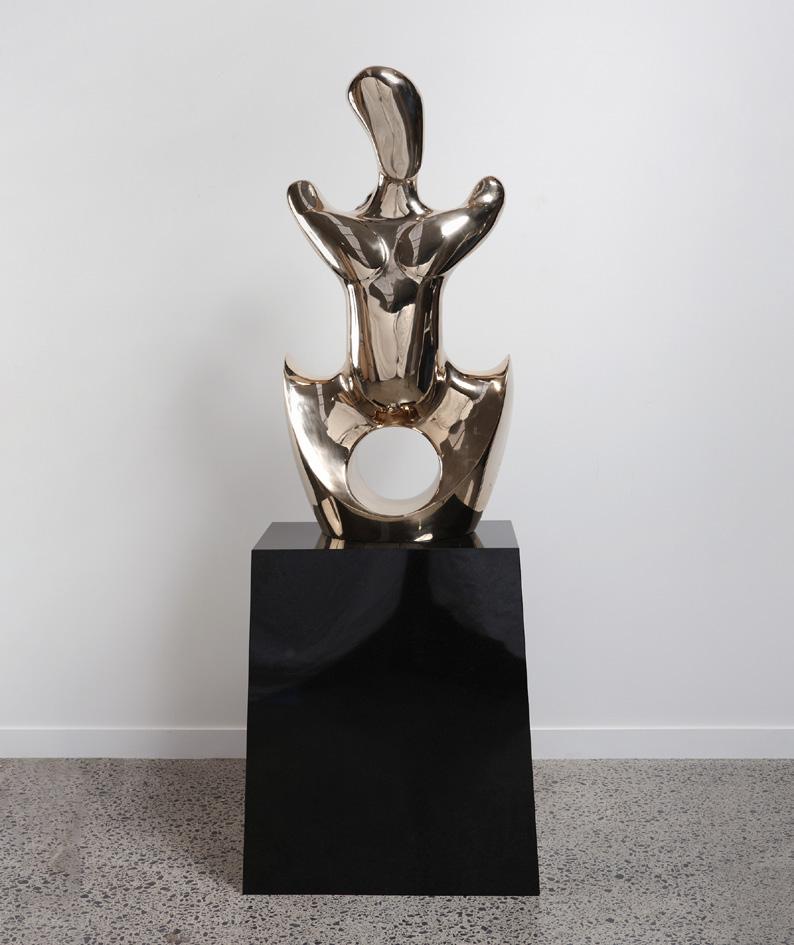
harakeke fibre, supplejack, steel cable, albatross feathers, basalt installation: 3800 x 1080 x 2220 mm (dimensions variable)
Tapuwae is a visual whakapapa, built of (laddered supplejack) footsteps back and forth across time, united by the rising and falling flax-strands which become multiple flowing streams of entwined blood and breath, land below, sky (and the future) above. The multi-layered expression of whakapapa within Tapuwae also alludes to a genealogical relationship to Parihaka, the home of passive resistance and the liberation ideology of Te Whiti-o-Rongomai and Tohu Kākahi.1 The three rosettes comprised of albatross feathers implicitly signify the ‘teaching of the spiritual leaders’2 and broaden the narratives to include the significant link between Parihaka and Otago.
1 Ngahina Hohaia, artist notes, 2023.
2 Nigel Borrell (Eds) Toi Tū Toi Ora: Contemporary Māori Art, Auckland Art Gallery, Penguin, 2022 p.349.
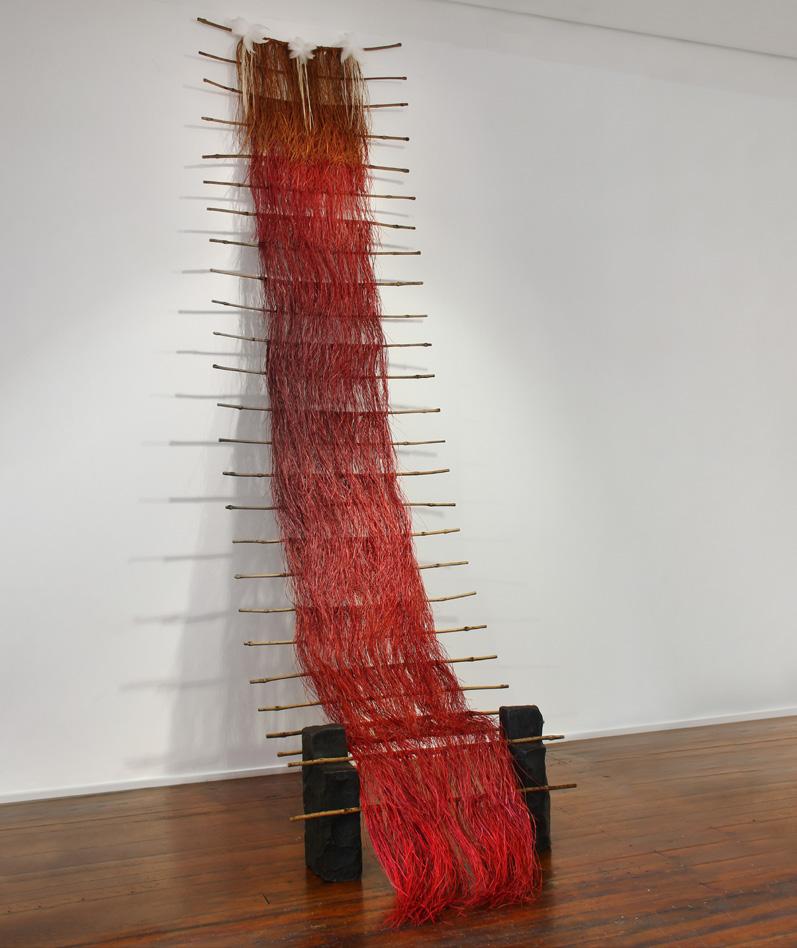
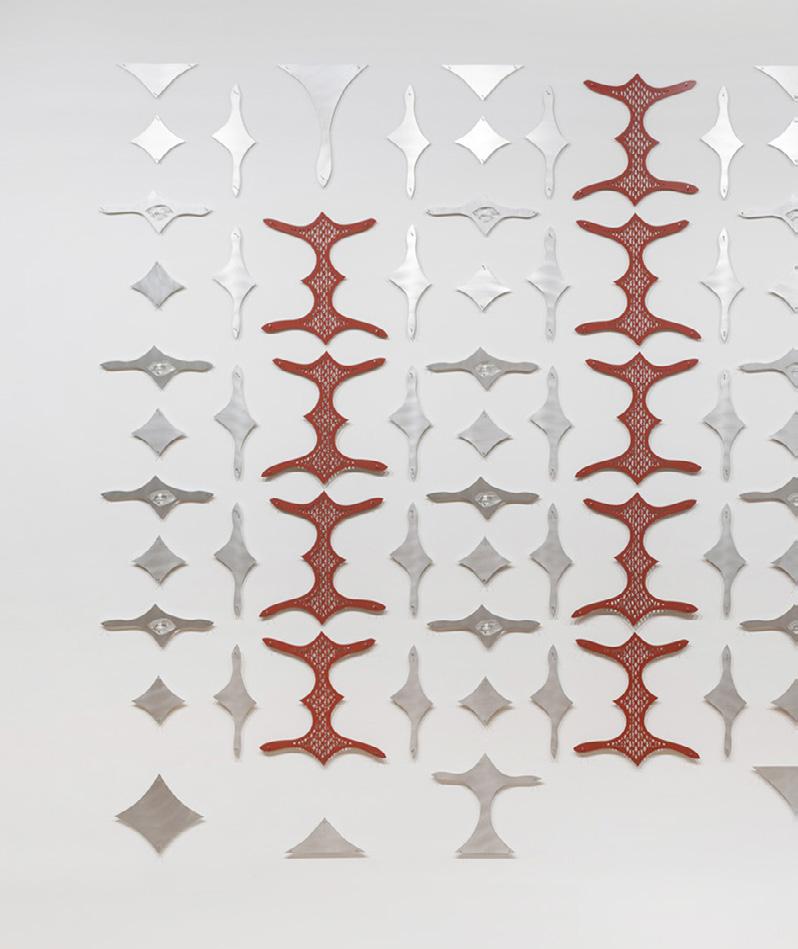
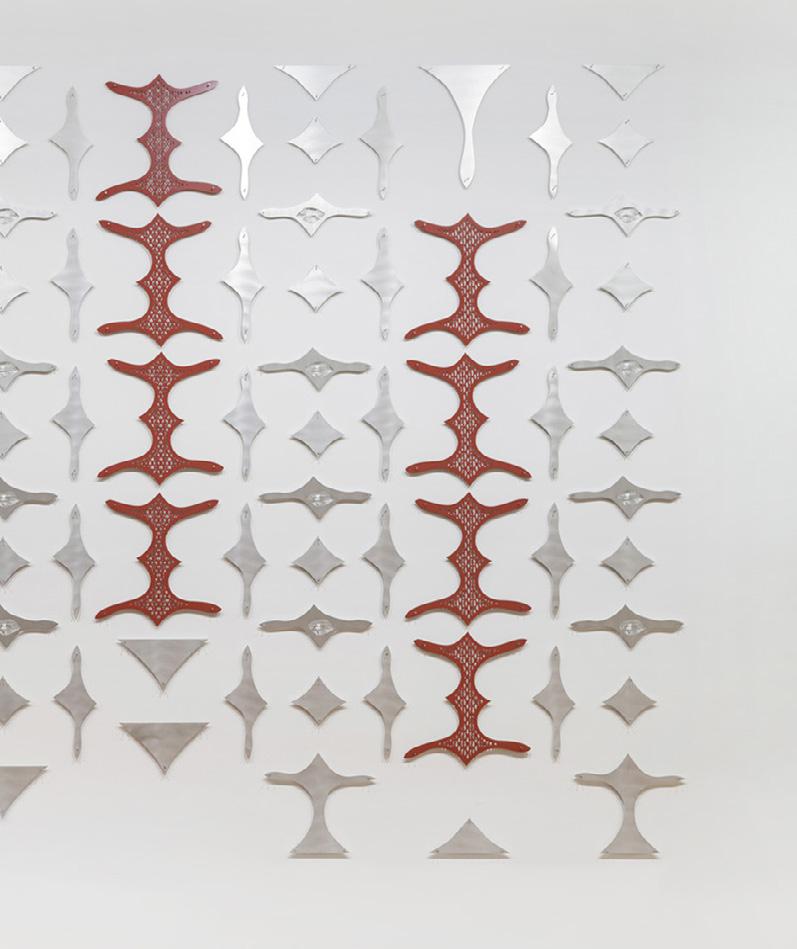 Lonnie Hutchinson, Hibiscus Cave (2021)
Lonnie Hutchinson, Hibiscus Cave (2021)
Hibiscus Cave (2021)
118 piece installation; brushed, powdercoated aluminium installation size on wall: 3260 x 5000 mm
Linking Lonnie Hutchinson’s Samoan and Māori whakapapa, Hibiscus Cave is directly informed by the rock drawings at the Takiroa cave site at Duntroon, Waitaki Valley, North Otago with the larger kōkōwai, red ochre, shapes recalling the human figures there and also carving in general. The smaller cut-out shapes reference seaweed along Te Waipounamu, providing another narrative link to the seasonal, migratory usage of the caves. In this major work, Hutchinson’s characteristic use of positive and negative space builds considerable visual rhythms where pattern and shadows float in space as well as back and forth across time.1
Provenance: exhibited Wairua Māori Art Gallery, Whangārei 24 June – 16 October 2022 and The Suter Art Gallery, Nelson November 19 – February 12, 2023.
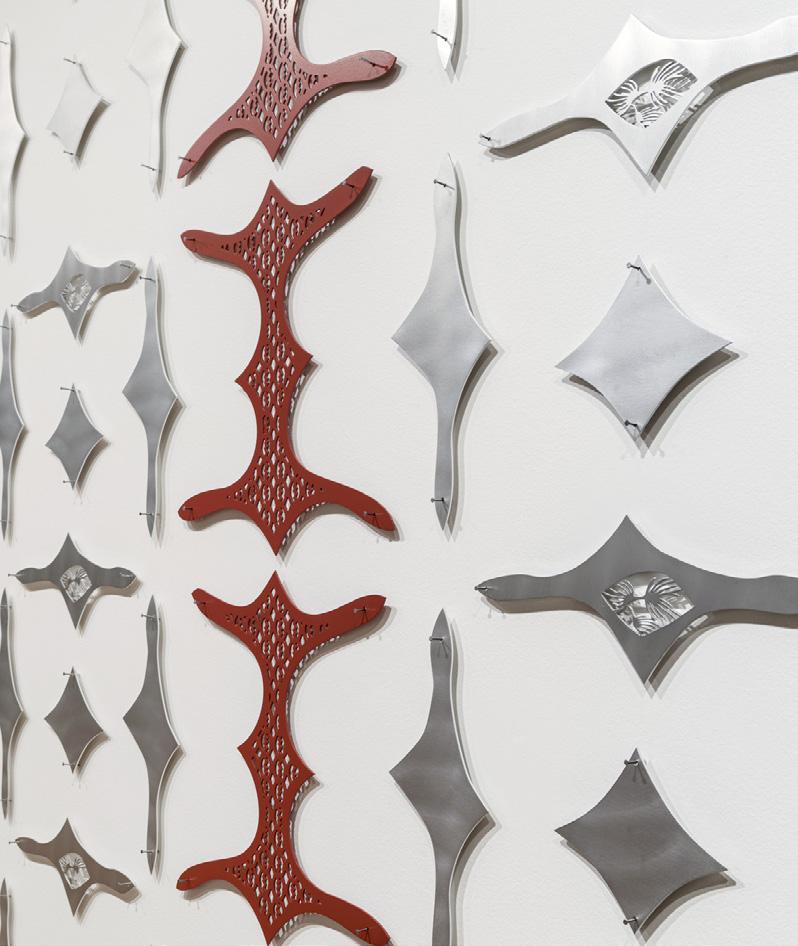
Aroha (2002) powdercoated aluminium edition of 6 size: 1145 x 1330 x 95 mm
Hutchinson’s cut-out and multi-cultural folded works have quite rightly been accorded signature status. Incorporating repeated patterns which explicitly reference kōwhaiwhai and the leaves of native plants, the folded forms utilise the ever-changing mutability of light on the surface; and in the fluxing shadows behind another conversation emerges about non-materiality, and the inter-connected spaces between all things, people and places.
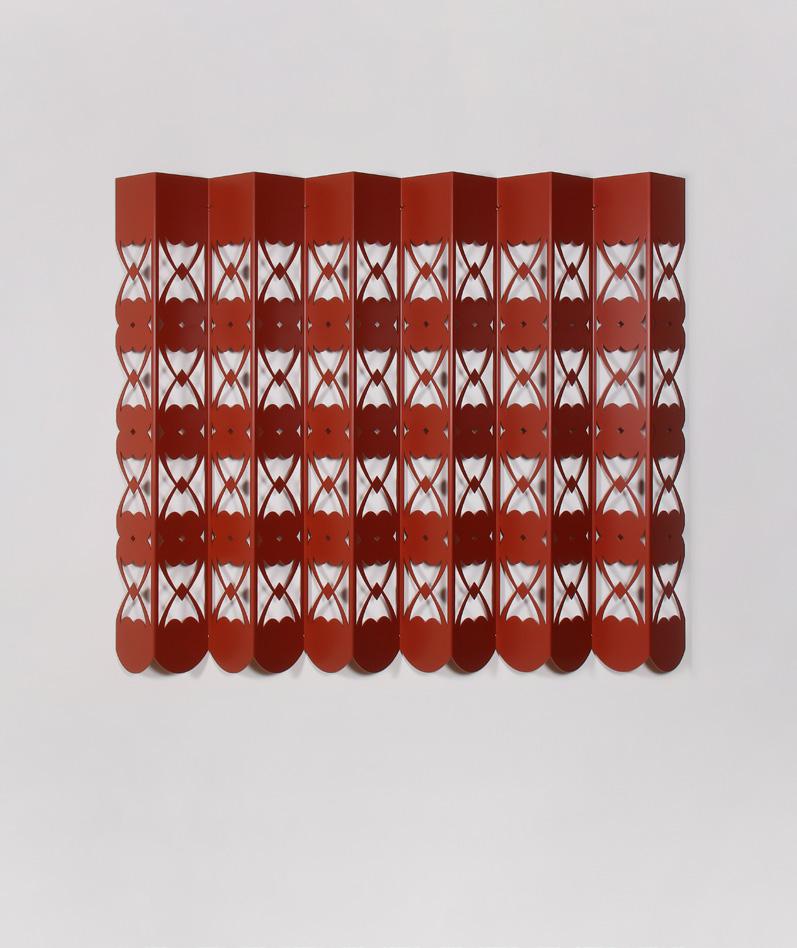
22
Puhoi (2022) powdercoated aluminium edition of 6
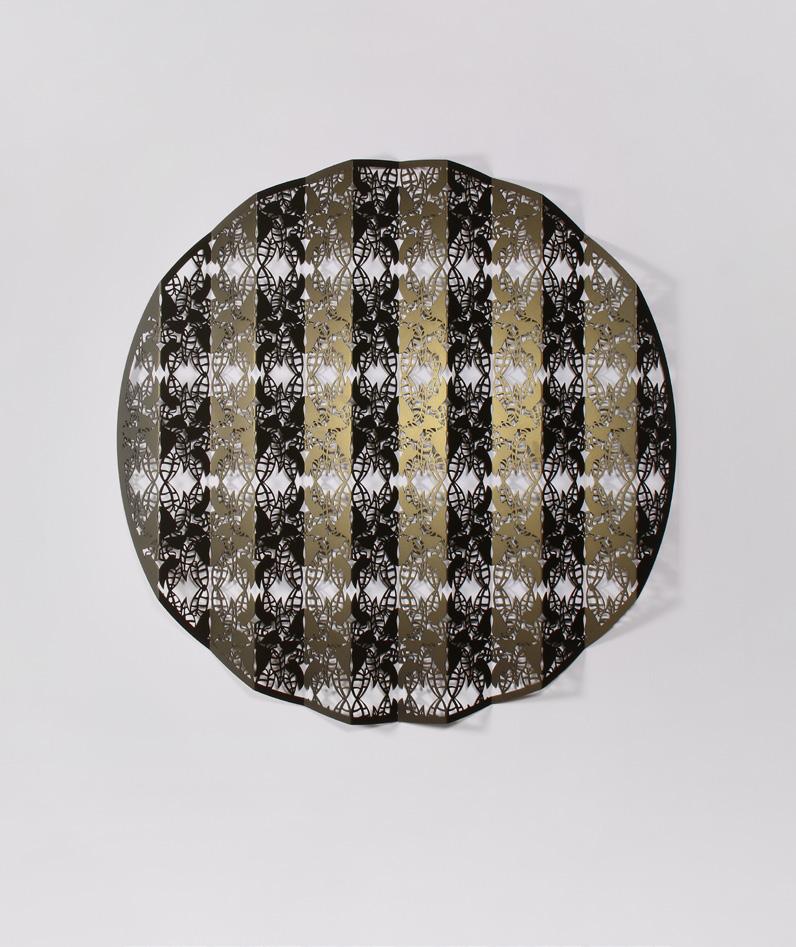
polished stainless steel, kauri
size: 955 x 300 x 60 mm
In this resolutely political work Jahnke reuses the surveyor’s peg – the ubiquitous tool which cut and partitioned the NZ landscape up by separating Māori from tribal lands and in that manner sanctioning and recognising in law settler’s ownership. Incised stencilled words, a stylised British crown atop stand revealed in the mirror image reflection.

Purehuroa Mā (2021)
metal, wood, paint, neon, one way glass, mirror, electricity size on wall: 1200 x 1200 x 211 mm
Robert Jahnke’s practice interrogates socio-political and historical structures in Aotearoa. He employs language, text, and symbol with form and pattern to create a complex discursive space that explores the way te Ao Māori exists within a colonised world.
Jahnke ‘delves into Māori creation narratives and prophetic imagery … explores the narrative of Te Kore … conveys ideas in relation to Te Po and Te Ao Mārama … reflect on whakapapa as the ultimate system of order, while echoing the Māori philosophical concept of continuous time and infinite possibilities.’1 Jahnke emphasises the expansive and endless nature of time and space. He uses the infinity of reflection, the contrasts of light and dark as he presents an open-ended conversation on Māori notions of existence and time, sculpted in neon and glass.
In this multi-perspectival space these multitudes are present, visually, reflecting and bouncing and overlapping into every corner of his neon works. The statements advance forwards and stretch back into infinite depths and, after a while, the shapes and patterns themselves become secondary to the fluid, shifting optical effects of the lighted mark-making.


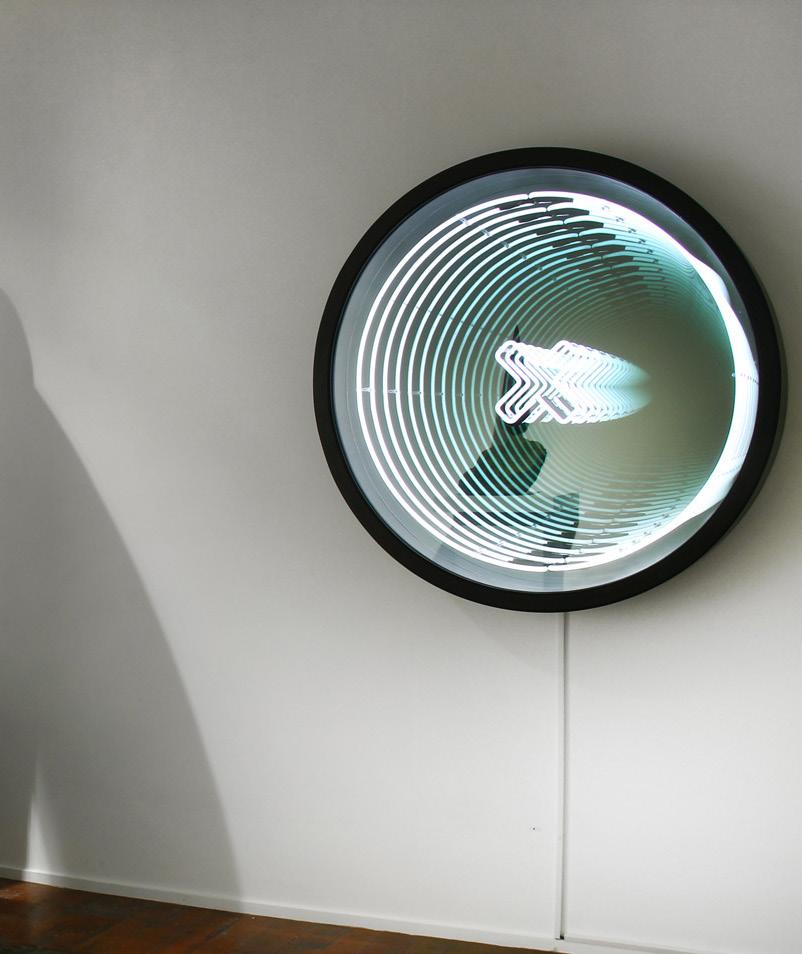
neon, one way glass, mirror, electricity, plinth varied edition 1 of 2
glass cabinet: 512 x 1500 x 500 mm
plinth: 1025 x 1500 x 500 mm
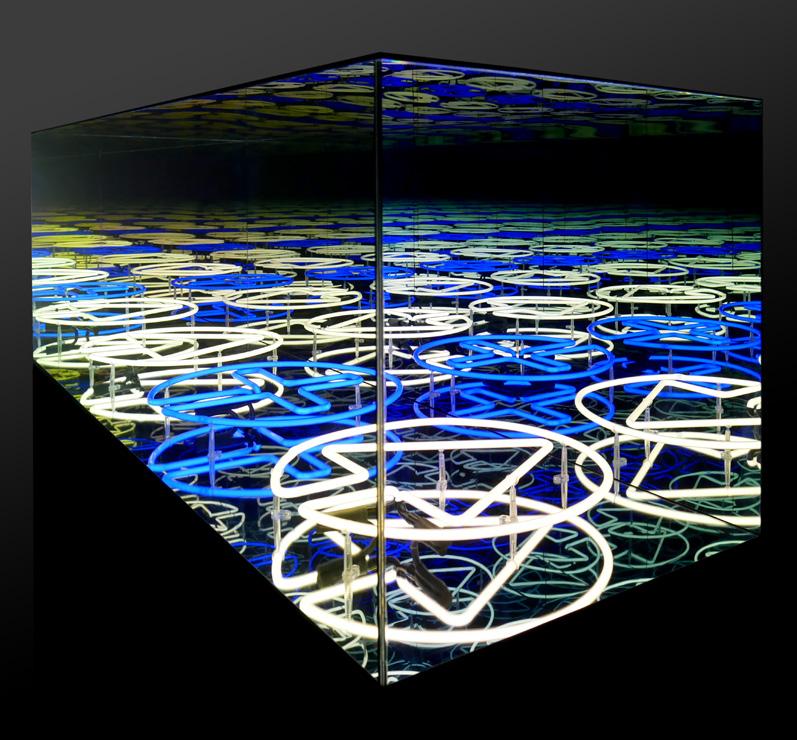
corten steel
size: 2990 x 1066 x 952 mm
signed, titled on plaque, side of base
Paradox sits at the heart of Ben Pearce’s corten steel sculptures: they are strong, angular, seem comprised of abstracted rock-like forms and are at first reading brutalist. At the same time, they are soft and beautiful as well as totemic in character functioning as guardians and protectors of the environments they exist in. Arching in a helix spiral upward, the works exude a state of calm and being.
The faceted angles and intersections morph and change with every viewing position. Suggestions and intimations emerge: in the aptly titled Atlas we recognise the emergent presence of the human form. In Eyro Pearce employs the visual contradictions of thick and thin, flat and angled as well as other visual devices which reveal his work to be very confident and extremely nuanced as it alters before our very eyes.
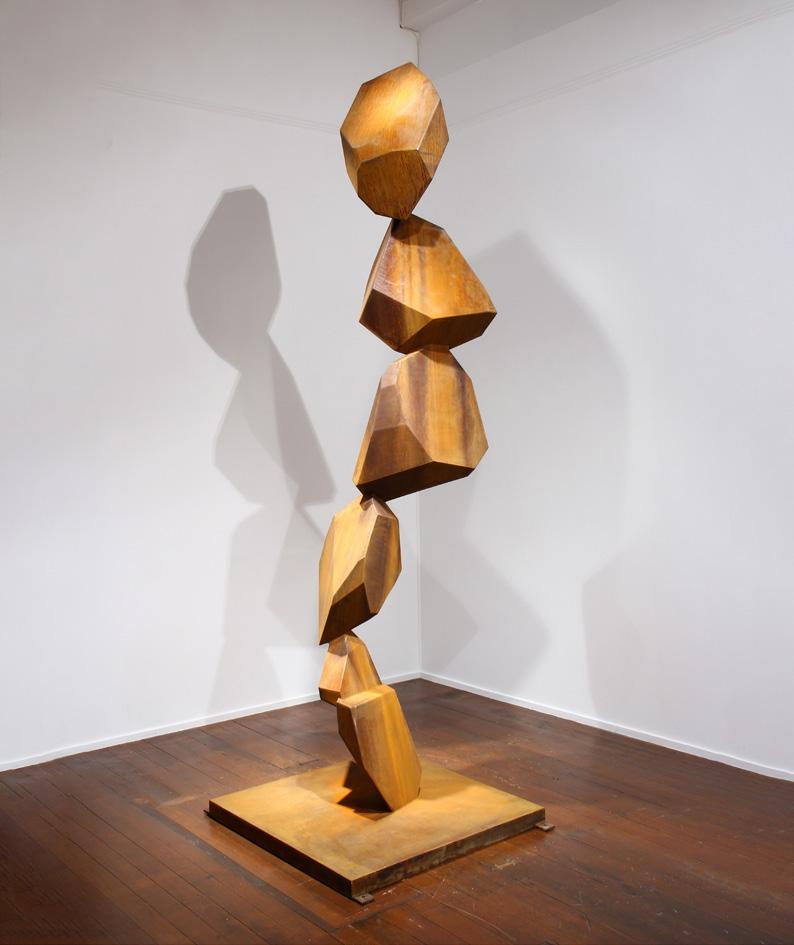
27
corten steel
size: 3003 x 900 x 900 mm
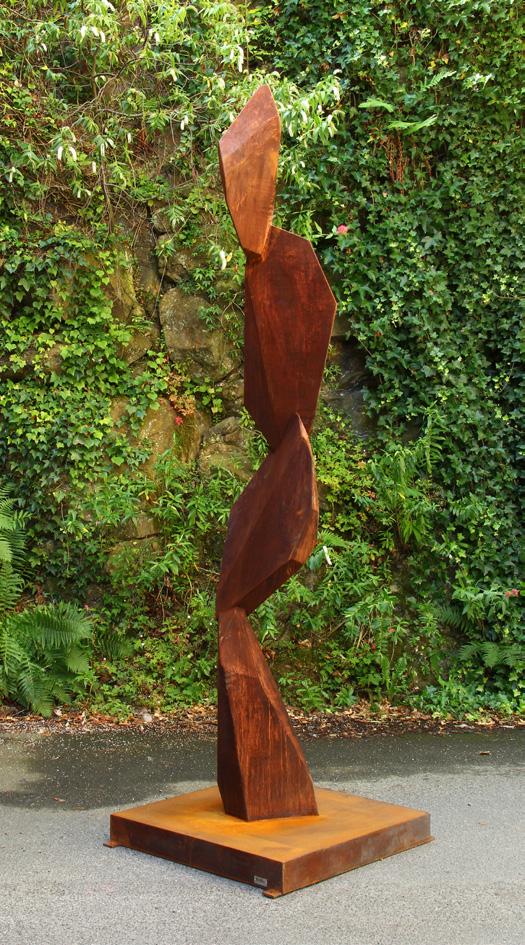
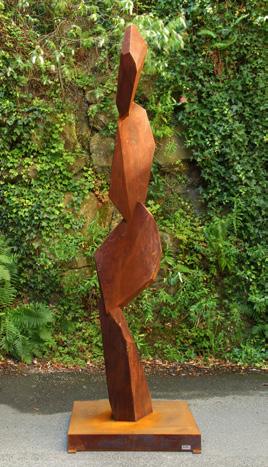
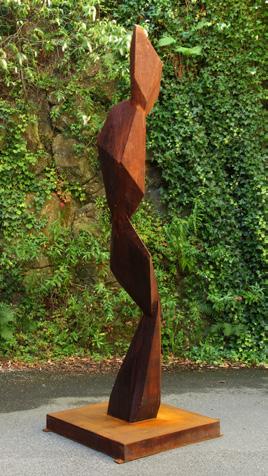

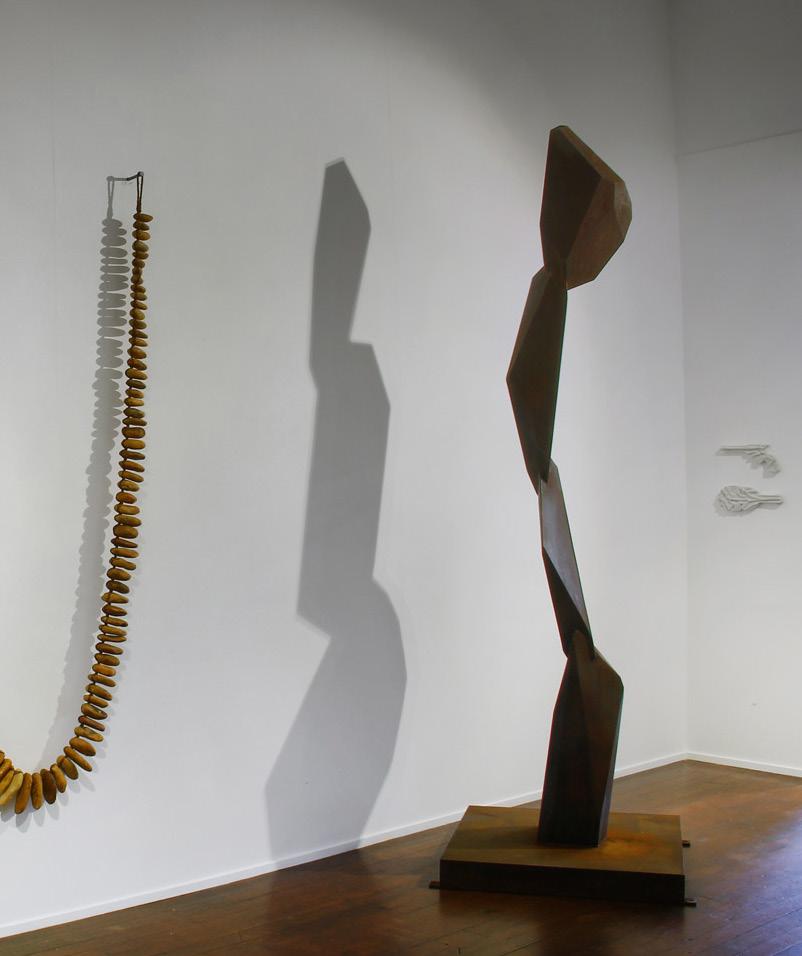
Disco Dinornis (2005)
high temperature epoxy, carbon fibre, precision bearings, stainless steel
dimensions variable
height: 5400 - 8020 mm
rotating blade: 3770 x 390 mm
projection: 2810 mm from centre of rotation in any direction
Regarded as the foremost kinetic sculptor of his generation and undertaking major commissions world-wide, Phil Price has focused on wind activated sculpture since 2000. His work is widely acknowledged for its sinuous beauty, evocation of the natural world and extraordinary carbon fibre composite construction and design.
The appropriately titled Disco Dinornis twists and turns, falls and rises, transforming its shape in a manner that is beguilingly rhythmic. It dances, holds positions, then almost imperceptibly alters. It stops, it starts, stands tall, crouches, changes shape in an endless dance as it is kissed by the wind.
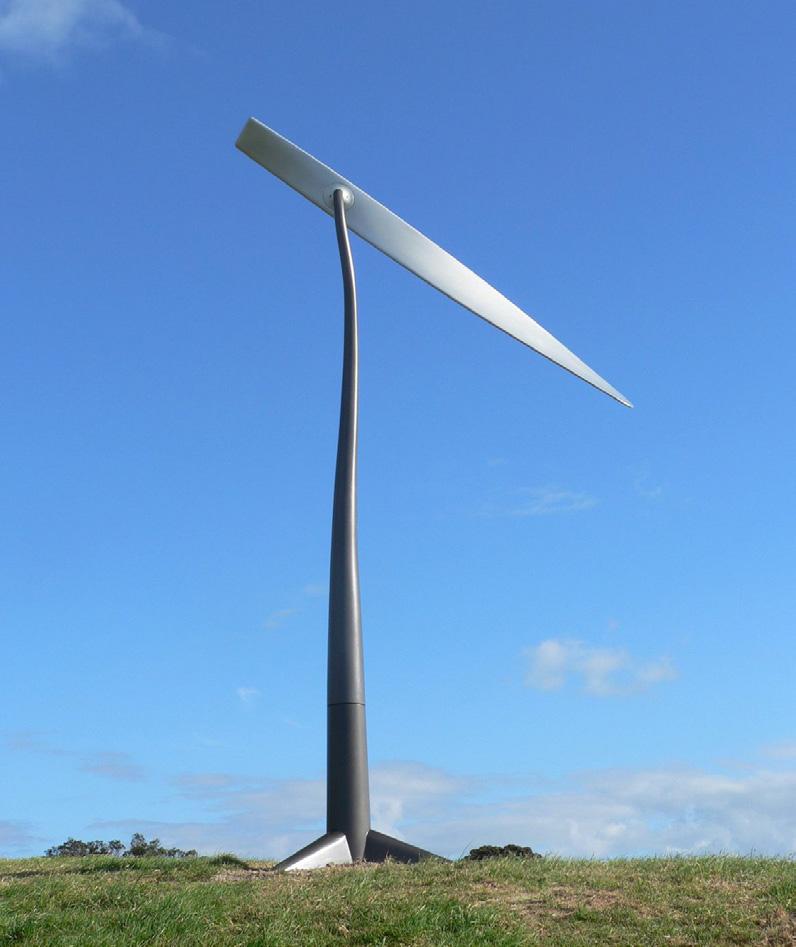
Pistol and Kotiate (2013)
2 pieces; carrara marble
pistol: 145 x 329 x 31 mm
kotiate: 137 x 359 x 31 mm
Selman celebrates and subverts tradition. He combines a range of modernist approaches in a representational narrative choosing to replicate in all its intricacy the specific detail of his subject. The acute precision of his observation and technical expertise is self-evident.
In Pistol and Kotiate, he uses the visual device of softly draped cloth covered objects to build an incisive, multiple narrative about the battles and tribulations of colonial New Zealand.
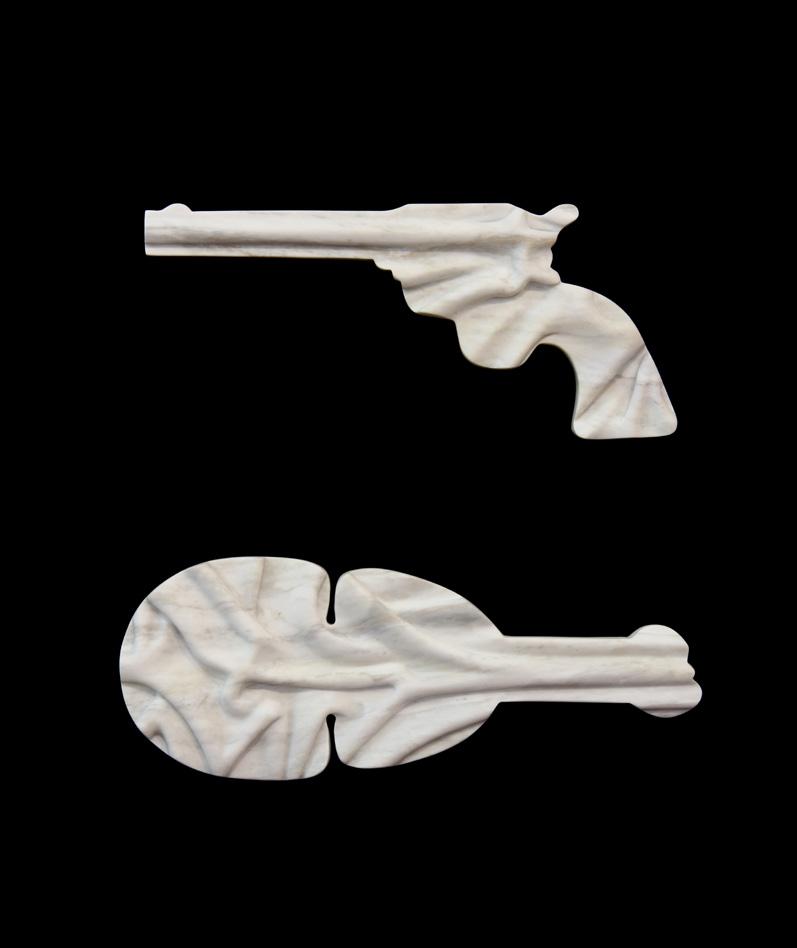
cast bronze
unique size: 1775 x 935 x 935 mm signed, dated on base
Terry Stringer has pioneered a unique dialect where his chimeric, shifting forms and trademark illusions while explicitly referencing the classical traditions of statuary forge a relationship between the perceived and the suggested, the real and unexplainable and spirituality itself; where parts suggest a greater whole, where the rules of form and proportion have been shifted.
The important Head Shine is in a state of continual transition. Presence and absence are expressed simultaneously and the work viewed in the round reveals itself to be in a continuous state of transition. He presents the dome of the head as a religious container, a shrine, while in the columns body portions suggest far more about what is not there. There are inscribed flowers and flames acting as iconographic vignettes inside the space. These still-life mementoes, morphing forms and the visual tensions between enclosed space and displaced space exist as vivid examples of Stringer’s metaphorical, narrative powers as he builds and delivers an abstracted, mutable sacred space.
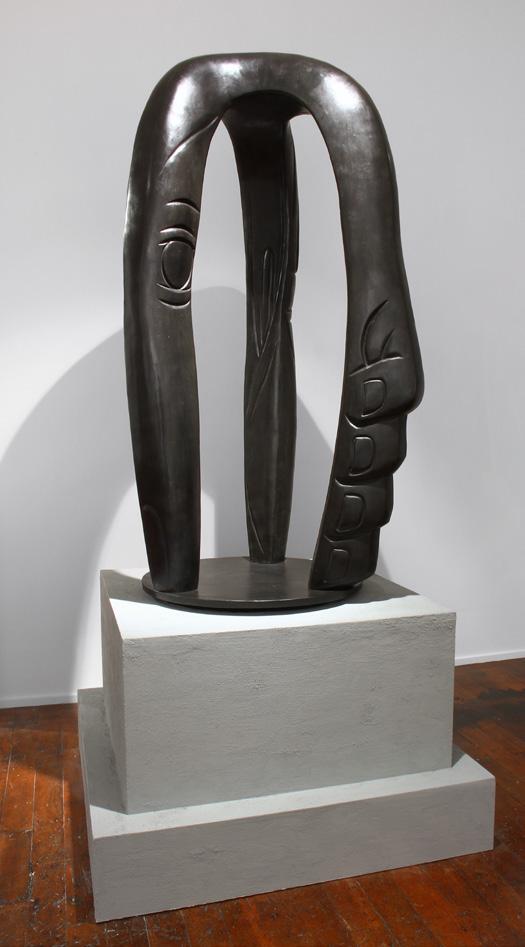
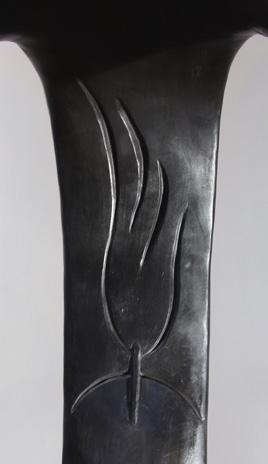
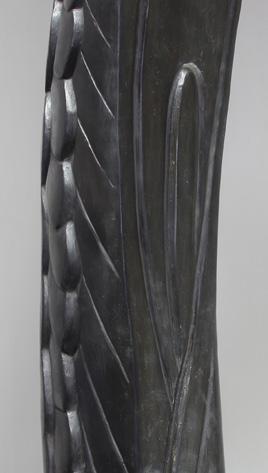
Te Ngau o te Rangi (2021)
Te Iti ō Hauraki (2021)
Be It On Our Heads (2017)
click on artist name to view page
CHRIS CHARTERIS
Converse (2008/22)
Hawks Crag (2015)
Te Waimate (2023)
Wasekaseka (2021)
Great Southern Ocean (Triple Strand) (2022)
Pukeko Down (2023)
Kaka Down Feather (2022)
Parallel Worlds (2013)
The Long View (Second Study) (2022)
Ngā Whetū Toko / Nine Stars 1 (2022)
All prices are NZD and include GST. Prices are current at the time of the exhibition.
42,500 62,500
65,000 30,000
40,000 POA POA
Trinity (2022) POA
49,500 POA 30,000 14,500
42,500
ANTON FORDE
LYONEL GRANT
Whakaruru / Protector 6, 13, 16, 17 (2022)
Māhutonga Roimata Uriuri - The Southern Cross Dark Teardrop (2021)
Our Lady (2003)
Tapuwae (2023)
LONNIE HUTCHINSON
Hibiscus Cave (2021)
LONNIE HUTCHINSON
LONNIE HUTCHINSON
ROBERT JAHNKE
ROBERT JAHNKE
ROBERT JAHNKE
BEN PEARCE
NGAHINA HOHAIA BEN PEARCE
PHIL PRICE
Aroha (2022) Puhoi (2022)
Common Law Rights (2004)
Mā
ATA AMIO (2022)
TERRY STRINGER
EYRO (2023)
Disco Dinornis (2005)
Pistol and Kotiate (2013)
Head Shrine (2020)
All prices are NZD and include GST. Prices are current at the time of the exhibition.
